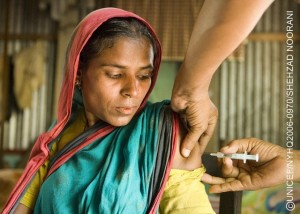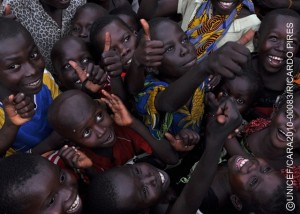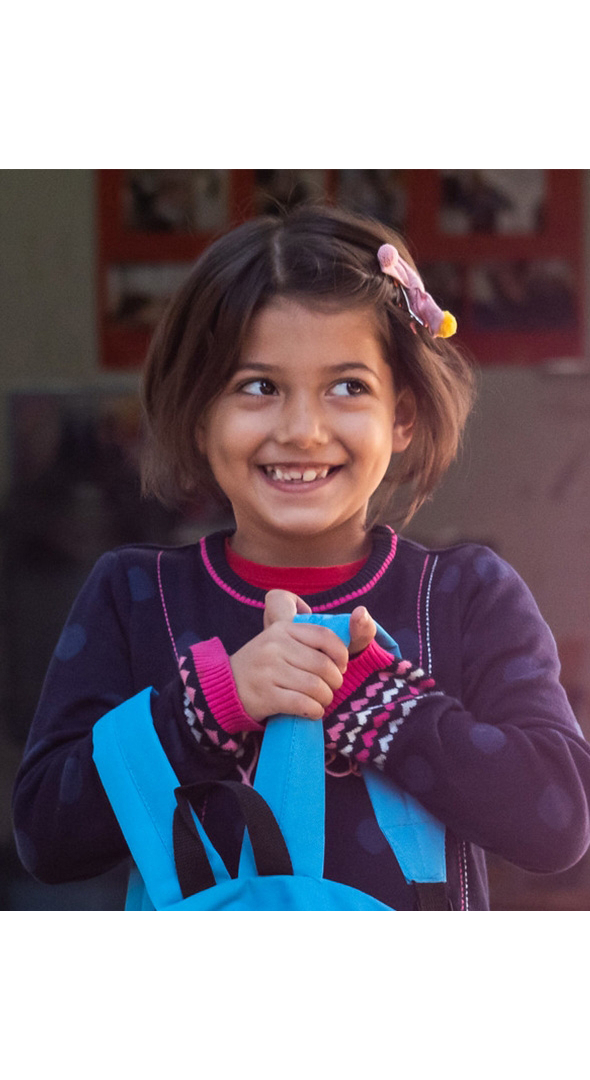合作伙伴報捷:59個重點國家逾半已成功擊退破傷風
2013-05-15
紐約/香港,2013年5月15日──「根除孕產婦和新生兒破傷風倡議項目」的合作伙伴,今天在年度會議中宣布,全球59個重點國家中,逾半已成功擊退的母嬰殺手的致命元凶之一──破傷風。
每9分鐘便有1名新生兒死於破傷風,當中幾乎所有夭折的新生兒,都是出生於最弱勢地區及社區的貧困家庭。
 |
![A health worker prepares a pentavalent vaccine at a health centre in the community of Corosal in Cobán Municipality, in Alta Verapaz Department. The pentavalent vaccine protects against five common diseases: diphtheria, tetanus, pertussis (whooping cough), hepatitis B and Haemophilus influenza type b (also called Hib, a cause of pneumonia and meningitis). The centre, which is open once a month, serves a population of 1,000, and is run by the Ministry of Health with support from UNICEF. Volunteer health workers provide routine health care and immunizations for pregnant women and children under 5 in five surrounding communities. [#2 IN SEQUENCE OF THREE] In November 2012 in Guatemala, the Government and other partners are continuing to assure sustained routine immunization of children now reaching 92 per cent of all infants against a range of vaccine-preventable diseases. The countrys last endemic case of measles was in 1997. In the entire Americas Region (covering North, Central and South America), the last endemic measles case was in 2002 and the last endemic case of rubella was in 2009 part of global efforts to eradicate these diseases. Worldwide, measles remains a leading cause of death among young children: In 2010, an estimated 139,300 people mainly children under the age of 5 died from the disease. Nevertheless, these deaths decreased by 71 per cent from 2001 to 2011, thanks in part to the Measles & Rubella Initiative, a global partnership led by the American Red Cross, the United Nations Foundation, the United States Centers for Disease Control and Prevention (CDC), WHO and UNICEF. In Guatemala, despite this success, significant other challenges for children remain, much of it related to poverty levels that affect more than half of all children and adolescents. Poverty also contributes to chronic malnutrition affecting half of all under-5 children (with higher rates among indigenous populations); an average national education level of under six years of primary school (under three years for the rural poor); and high, though decreasing, rates of violence. Guatemala is also one of the worlds most vulnerable countries to climate change, suffering a major climate-related emergency every year since 2008. On the positive side, birth registration is improving, with more than 95 per cent of newborns now being registered. UNICEF is working with the Government and other partners to sustain achievements in health, address the high levels of malnutrition, strengthen responses to crimes against children and increase protection services for children throughout public services.](/wp-content/uploads/2015/12/20130515_tetanus_4-300x214.jpg) |
自1999年起,全球52個國家已有逾1.18億名達到生育年齡的婦女接受了破傷風防疫注射。她們當中很多都參加了綜合計劃,在接受破傷風防疫注射的同時,亦獲得麻疹防疫注射、維他命A補充劑、驅蟲劑以及臍帶護理資訊等保護兒童健康的服務。
| 「根除孕產婦和新生兒破傷風倡議項目」,是一項展示出伙伴如何合力取得成果的典範。2000年,即項目開始後一年,當時估計每年有超過20萬名新生兒死於破傷風;到2010年,因破傷風而夭折的嬰兒數目,已下降至每年約58,000宗。 縱使項目有所進展,現時仍有逾28個重點國家尚未達到根除破傷風的目標。要在2015年前達成全球目標──在所有重點國家根除孕產婦和新生兒破傷風,實在困難重重。 局勢不穩、文化障礙、與其他重點工作爭奪執行的優先次序、確保確診後推行持續的根治工作,以及資金不足,都是妨礙工作人員進入社區,推行根除孕產婦和新生兒破傷風工作的主要挑戰。 |
![(Right) Alba Flor Bol, an indigenous Mayan woman, holds her 3-month-old daughter, Esteyner Leandrinho Chen, as health worker Lourdes Rodriguez administers a pentavalent vaccination, at a health centre in the community of Corosal in Cobán Municipality, in Alta Verapaz Department. The pentavalent vaccine protects against five common diseases: diphtheria, tetanus, pertussis (whooping cough), hepatitis B and Haemophilus influenza type b (also called Hib, a cause of pneumonia and meningitis). The centre, which is open once a month, serves a population of 1,000, and is run by the Ministry of Health with support from UNICEF. Volunteer health workers provide routine health care and immunizations for pregnant women and children under 5 in five surrounding communities. [#3 IN SEQUENCE OF THREE] In November 2012 in Guatemala, the Government and other partners are continuing to assure sustained routine immunization of children now reaching 92 per cent of all infants against a range of vaccine-preventable diseases. The countrys last endemic case of measles was in 1997. In the entire Americas Region (covering North, Central and South America), the last endemic measles case was in 2002 and the last endemic case of rubella was in 2009 part of global efforts to eradicate these diseases. Worldwide, measles remains a leading cause of death among young children: In 2010, an estimated 139,300 people mainly children under the age of 5 died from the disease. Nevertheless, these deaths decreased by 71 per cent from 2001 to 2011, thanks in part to the Measles & Rubella Initiative, a global partnership led by the American Red Cross, the United Nations Foundation, the United States Centers for Disease Control and Prevention (CDC), WHO and UNICEF. In Guatemala, despite this success, significant other challenges for children remain, much of it related to poverty levels that affect more than half of all children and adolescents. Poverty also contributes to chronic malnutrition affecting half of all under-5 children (with higher rates among indigenous populations); an average national education level of under six years of primary school (under three years for the rural poor); and high, though decreasing, rates of violence. Guatemala is also one of the worlds most vulnerable countries to climate change, suffering a major climate-related emergency every year since 2008. On the positive side, birth registration is improving, with more than 95 per cent of newborns now being registered. UNICEF is working with the Government and other partners to sustain achievements in health, address the high levels of malnutrition, strengthen responses to crimes against children and increase protection services for children throughout public services.](/wp-content/uploads/2015/12/20130515_tetanus_5-300x214.jpg) |
![Nurse Emmanuel Kalwazi fills a syringe with tetanus toxoid vaccine, which he will administer to a pregnant woman in Mukanga-Moke Village, Katanga Province. The vaccines have been provided by UNICEF. [#4 IN SEQUENCE OF ELEVEN] In Feuary 2011 in the Democratic Republic of the Congo, women and children remain vulnerable to maternal and neonatal tetanus (MNT), an infection that has no cure but is preventable with routine immunization. MNT threatens the lives of 130 million women and babies in 38 countries around the world, including D. R. Congo, where the disease sickened at least 1,038 babies and killed 483 last year. Globally, the disease kills 59,000 infants within their first month of life, the equivalent of one death every nine minutes, every year. Limited access to basic health services and poor hygiene conditions during birth are the major contributors to MNT mortality: Many infections take place when women give birth at home, alone or in the presence of an untrained birth attendant. Delivery on unclean surfaces and handling with unclean hands or instruments increase the chance of MNT infection in both mother and baby. Yet three doses of the tetanus toxoid vaccine one of the worlds safest and least expensive vaccines protects almost 100 per cent of recipients from the disease. Additionally, children born to immunized women are protected from the disease for the first two months of life. Since UNICEF re-launched its MNT Elimination Initiative in 1999, at least 20 countries have achieved the goal of eliminating MNT, and since 2006, private-sector partner Pampers has donated funds for 300 million vaccines. In D. R. Congo, this initiative is promoting vaccination among girls and women of child-bearing age, particularly in southern provinces where health infrastructure is weak and vaccine shortages are common. The goal of the initiative is to eliminate cases of MNT from the world by 2015.](/wp-content/uploads/2015/12/20130515_tetanus_3-300x214.jpg) |
 |
仍需致力根除孕產婦和新生兒破傷風的國家包括:阿富汗、安哥拉、柬埔寨、中非共和國、乍得、剛果民主共和國、赤道幾內亞、埃塞俄比亞、加蓬、幾內亞、海地、印度、印尼、肯尼亞、老撾人民民主共和國、馬達加斯加、馬里、毛里塔尼亞、尼日爾、尼日利亞、巴基斯坦、巴布亞新幾內亞、菲律賓、塞拉利昂、索馬里、蘇丹、南蘇丹和也門。









